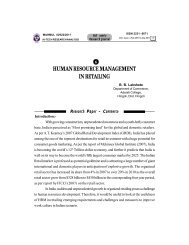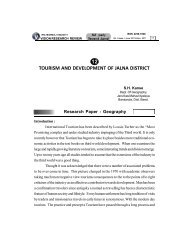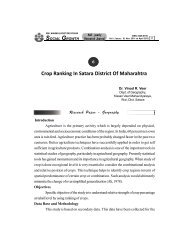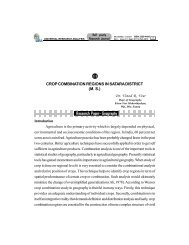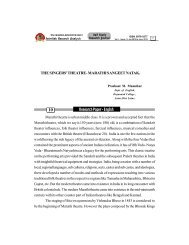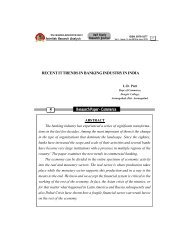A Geographical Study Of Food Grain Cropping Pattern
A Geographical Study Of Food Grain Cropping Pattern
A Geographical Study Of Food Grain Cropping Pattern
You also want an ePaper? Increase the reach of your titles
YUMPU automatically turns print PDFs into web optimized ePapers that Google loves.
UNIVERSAL RESEARCH ANALYSIS<br />
Temporal Analysis :-<br />
In general ,the area of jowar has<br />
decreased in all the tahsils in the district<br />
except Mangalwedha and Barshi tahsils.<br />
The area under jowar declined by about<br />
4 percent to 40 percent in the period from<br />
1990-91 to 2004.05 in all over the dis-<br />
trict. However, the area of this crop in-<br />
creased in Mangalwedha (14.49 percent)<br />
and Barshi (3.76 percent) tahasil.<br />
Mangalwedha is a major producer of<br />
Maldandi jowar in the study region as<br />
well as in Maharashtra. In Mangalwedha<br />
tahasil 60.45 percent area was under this<br />
crop in 1990-91 and it increased in<br />
2004-05 i.e. 74.94 percent .<br />
2) Wheat<br />
Wheat is the second important<br />
food crop in Solapur district. The bo-<br />
tanical name of wheat is Triticum Satuvum<br />
. Wheat ranks second among the food<br />
grains grown in the district. It accounted<br />
for 3.97 percent land in 1990-91, which<br />
increased by 7.01 percent of the net sown<br />
area in 2004-05.. Farmers grew wheat<br />
on small scale everywhere in the study<br />
area.<br />
Environmental Requirements:-<br />
Wheat is mainly a rabbi crop. It<br />
is adapted to varying condition of climate<br />
Half yearly<br />
Research Journal<br />
RNI. MAHMUL 13/2/2010 ISSN 2229-4406<br />
Vol. I , Issue :I I I, Sept. 2011 to Feb. 2012<br />
Table No 1<br />
6 4



